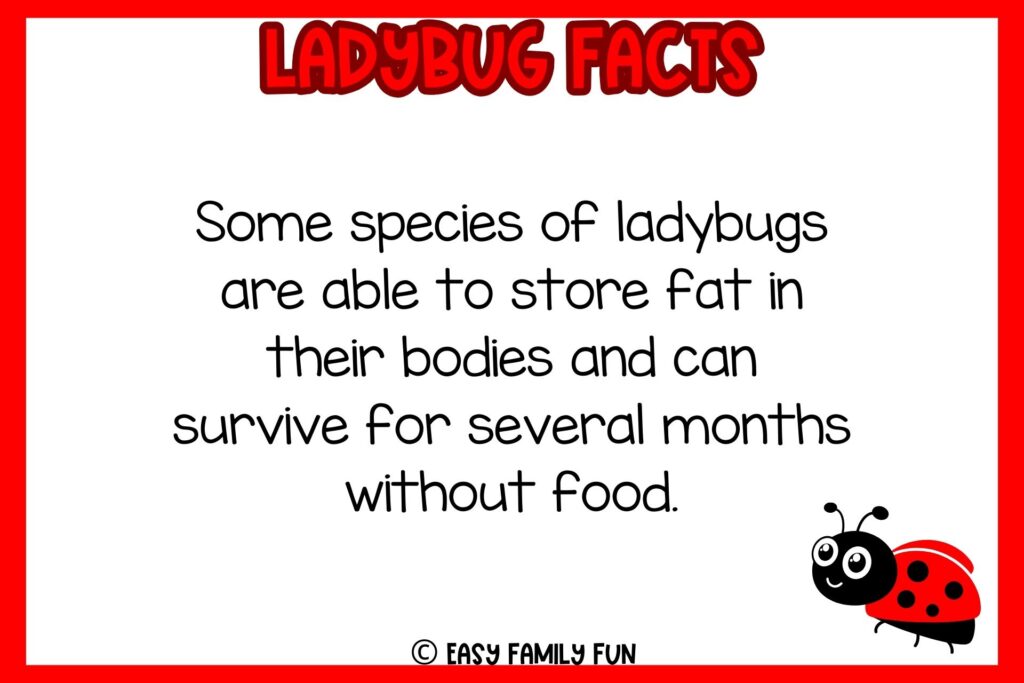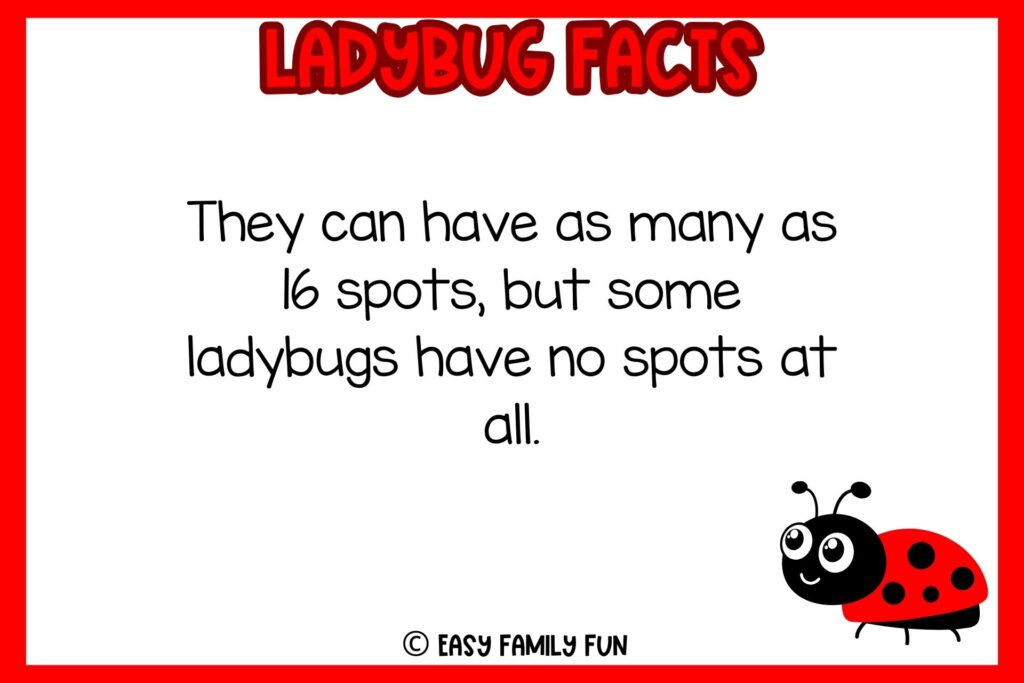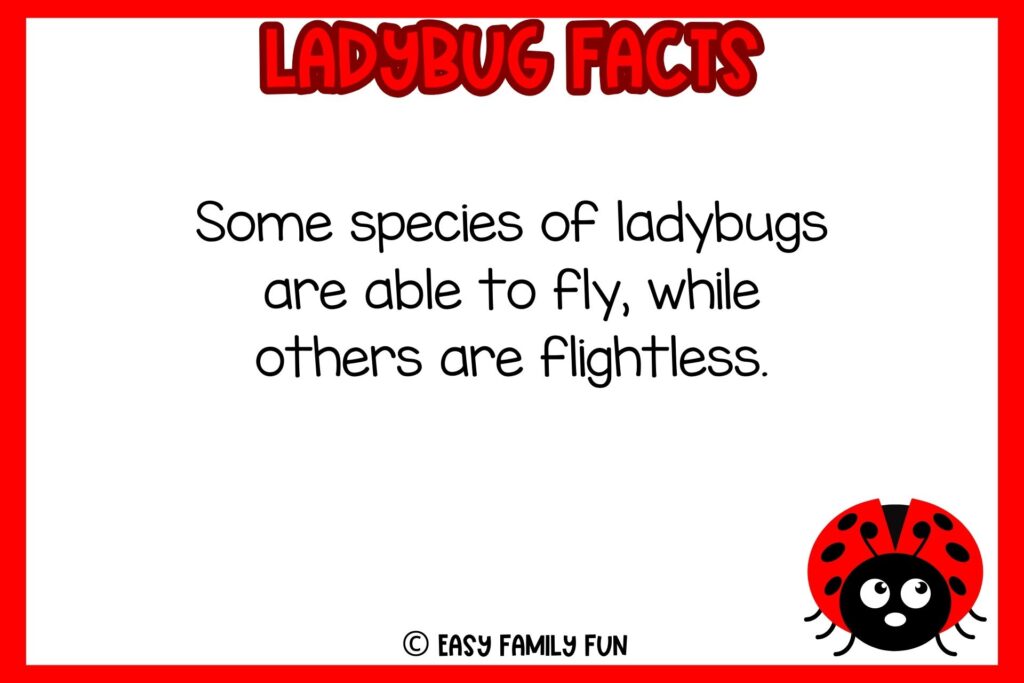Uncover interesting facts about ladybugs! From their rainbow of colors to their role as garden heroes, explore the intriguing world of these tiny insects. Perfect for young explorers and curious minds.

Get ready to dive into the enchanting world of ladybugs, those tiny, spotted insects that are as interesting as they are cute. These colorful critters are more than just pretty faces, and we’re here to share some fascinating facts about ladybugs that will make you appreciate them even more.
First off, did you know that ladybugs come in many different colors? While the red ones with black spots are the most famous, you can also find ladybugs that are orange, yellow, or even completely black with red spots. Talk about a stylish insect! But ladybugs aren’t just about looks. They are superheroes for your garden because they love to gobble up pesky pests and other tiny plant-destroying insects. Imagine having a tiny, spotted gardener helping to protect your plants!
Ladybugs also have some cool survival tricks up their sleeves. When they’re in danger, they can ooze out a smelly liquid from their joints to scare away predators. It’s like their own secret weapon! So, get ready to explore the world of ladybugs and discover more astonishing facts about these little wonders of nature. They might just become your new favorite insect friends!

Interesting Facts about Ladybugs

- Females will lay up to 1,000 eggs within a few months, generally from spring to early summer.
- Ladybugs are found in all continents except Antarctica.
- There are about 450 species of ladybugs on our continent, and they come in yellow, black, pink, orange, and brown. Additionally, some have stripes instead of dots.
- A ladybug’s bright colors warn predators to stay away.
- Some species of ladybugs are able to store fat in their bodies and can survive for several months without food.

- Once Laid, the Ladybug eggs incubate for a period of around 5 to 8 days before hatching.
- Ladybugs become more active once the temperature reaches near 60°F (16°C).
- They are most abundant in North America and Europe.
- The blood of a ladybug is yellow and contains a strong smell that predators dislike.
- Ladybugs live for about a year.

- Ladybugs smell with their feet and antennae.
- On rare occasions, these insects can live up to two years.
- Ladybugs stink. It’s part of their defense mechanism to keep predators away. And they will group together to become stinkier.
- The hard shell of a ladybug helps in protecting its organs.
- Ladybugs can fly up to 37 mph – that’s as fast as a Race Horse.

- Not all Ladybugs are carnivores, some ladybug species are known to eat plants instead of pests. Most Ladybugs also eat pollen, nectar, and honeydew.
- Some species of ladybugs are able to adapt to new habitats, such as farms and greenhouses.
- Ladybugs are able to fly long distances in search of food and mates.
- The more aggressive Asian Lady Beetle, also known as the Harlequin Ladybug is an invasive species released by the US government in the mid-1900s to help reduce the agricultural pest population. It has since led to the depletion of native species.
- Ladybugs belong to the order Coleoptera, which is the largest order of insects.

- Ladybugs are a common subject in art, literature, and folklore.
- Their spots fade in once they are a few hours to a day old. As they age, their spots fade out. Take a look next time you see one.
- There are about 5,000 different species of ladybugs in the world.
- These small insects are more accurately called ladybeetles or ladybird beetles.
- Ladybugs bleed from their knees when threatened.

- Not All Ladybugs Are Black and Red.
- Young ladybugs pause in growth during winter hibernation.
- Ladybugs can see in many directions at once. It also means that their quality of vision is not great and they can only see in black and white.
- Ladybug larvae resemble tiny alligators, with elongated bodies and bumpy skin.
- Most ladybugs have oval, dome-shaped bodies with six short legs.

- They Aren’t All Red With Black Spots
- he name ladybug was originally called “ladybird”. Originated in Britain where the insects became known as “Our Lady’s bird” or the Lady beetle.
- The ladybug was first discovered in the year 1853 in Colorado, USA.
- Ladybugs and ladybug larvae eat more than 50 different species of aphids, and can eat more than 500 aphids a day!
- They can have as many as 16 spots, but some ladybugs have no spots at all.

- Ladybugs taste horrible to predators because of the oily fluid in their legs.
- Ladybugs are named after the Virgin Mary.
- Ladybugs are attracted to bright lights and are often seen gathering near windows and lights at night.
- Ladybugs are only poisonous to animals and other bugs when they are consumed.
- Ladybugs have lots of defense mechanisms.

- The Scientific Name for Ladybug is Coccinellidae Septempunctata.
- Farmers Use Ladybugs to Control Other Insects. The first experiment on using ladybugs as pest controllers was in the late 1880s.
- The average size of a ladybug is between 3 and 8 mm.
- Underneath this shell are their hidden wings. These unfold at a speed of 0.1 seconds and are significantly bigger than the ladybug’s body.
- Some species of ladybugs are able to fly, while others are flightless.

- Ladybugs’ Numbers Are Declining.
- Ladybugs mainly communicate with each other through pheromones, these act as chemical signals.
- Ladybugs have short, rounded head with large eyes and a short, flexible neck.
- Ladybugs cannot fly when temperatures are below 55 °F (13°C).
- Their legs are short and have claws for clinging to surfaces.

- When Ladybugs Hibernate in groups, this is known as ‘diapause’
- Ladybugs chew by moving their jaws side to side.
- During the winter months, thousands of millions of Ladybugs can be seen congregating in South Western USA looking for hibernation spots.
- In 1999, four ladybugs went to space! The four lucky bugs were brought to space, along with their favorite snack, aphids, so that scientists could observe how the predators and their prey would interact in zero gravity.
- Ladybugs lay extra eggs as a snack for their young.

- Ladybugs usually protect themselves from predators in one of two ways: They either play dead or secrete a fluid from their legs to make themselves taste bad.
- Ladybugs do not breathe through their mouths, but through parts of their abdomen and thorax through openings called Spiracles.
- In Switzerland, ladybugs are called “good God’s little fairy.”

Are you looking for more fun and engaging facts to share with your family? Check out these other posts for more facts!
- 100 Fascinating Facts about Mexico
- 75 Fascinating Facts About France
- 100 Purr-fectly Delightful Facts About Cats
- 87 Fascinating Facts About Owls
- 103 Super Cool Facts About Space
- 100 Interesting Facts About Hurricanes
- Facts About the 9/11 Memorial
- Facts About Spring
- Facts About Rosa Parks
- 50 Fascinating Facts About Butterflies
- 50 Fascinating Facts About Eagles
- Facts About Rome
- Facts About Lions
- Facts about Big Ben
- 100 Best Facts About Quartz for Kids
- 100 Best Facts About Cheese For Kids
- 100 Best Facts About Canada for Kids
- 100+ Out-of-This-World Facts about Earth
- 100 Epic Bug Facts for Kids
- 100 Weird Facts About Animals for Kids
- 85 Stellar Facts About Jupiter
- 135 Fascinating Facts About Ireland That Will Make You Fall in Love
- 50+ Interesting Facts about the Nervous System [Fact Cards]
- 55 Interesting Facts About Seattle [Free Fact Cards]
- 55 Best Facts about Frogs [Free Fact Cards]
- 66 Best Facts About Blueberries [Free Fact Cards]
- 37 Best Facts About Bacon [Free Fact Cards]
- 65 Best Facts About Comets [Free Fact Cards]
- 85+ Best Titanic Facts [Free Fact Cards]
- Interesting Facts about Ladybugs [Free Fact Cards]
- Abraham Lincoln Facts You Should Know [Free Fact Cards]
- Dive Into These Facts About Jellyfish [Free Fact Cards]
- Interesting Banana facts [Free Fact Cards]
- 20 Interesting Facts About Red Wolves [Free Fact Cards]
- Mt. Rushmore Facts: Carving History in Stone [Free Fact Cards]
- 66 Best Facts About Blueberries [Free Fact Cards]
- Over 100 Fun Facts about North Carolina [Free Fact Cards]
- 79 Electrifying Facts about Lightning [Free Fact Cards]
- 56 Interesting Facts About Snakes [Free Fact Cards]
- 56 Interesting Facts About Snakes [Free Fact Cards]
- 53 Fascinating Facts about Spiders [Free Fact Cards]
- 74 Interesting Facts About New Zealand [Free Fact Cards]
- 50 Interesting Facts About Apples [Free Fact Cards]
- 100 Purr-fectly Delightful Facts About Cats
- Buzzing with Knowledge: Explore 65 Fascinating Facts About Bees!
- 100 Marvelous Facts About Monkeys
- Gallop Through Knowledge: With These 75 Fascinating Facts about Horses
- Travel Back in Time With These Facts About the 13 Colonies!
- 52 Facts About Neptune for the Future Astronauts in Your Family
- 40 Incredible Facts About Your Heart
- 25 Remarkable Facts about James Madison
- 35 Oink-some Facts About Pigs
- 50 Neck-Stretching Facts about Giraffes
- 65 Patriotic Facts about the Statue of Liberty
- 50 Incredible Facts About Turtles
- 40 Mischievous Facts About Raccoons
- 135 Fascinating Facts About Ireland That Will Make You Fall in Love
- 85 Stellar Facts About Jupiter
- 100 Weird Facts About Animals for Kids
- 100 Epic Bug Facts for Kids
- 100+ Out-of-This-World Facts about Earth
- 100 Best Facts About Canada for Kids
- 100 Best Facts About Cheese For Kids
How Do I Print A PDF?
You’ll need a program that supports PDFs. Adobe Acrobat is a great option. Open the program, click file, then print. Select your printer and the number of copies you want to print. Be sure you click double-sided if you want it to print on both sides.
Can I Resell These?
You may not resell any printable that you find on our website or in our resource library. You may use them for class parties, at church, at home, or in the classroom. You may get these printed at an office supply store or copy center at your own expense.
